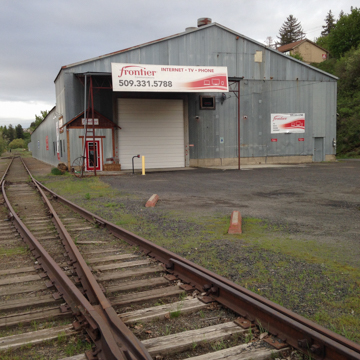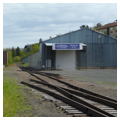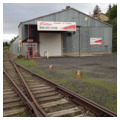You are here
Dumas Seed Company Warehouse
The Dumas Seed Warehouse is suggestive of the collective agricultural memory that people associate with the Palouse region of eastern Washington. This ordinary building is an improbable candidate to serve as a symbol of the region’s rural past and present, yet the stories of work, workers, and economy are embedded in its metal walls, revealing its importance in the cultural landscape.
Located in Pullman, the warehouse is an elongated, prefabricated steel building with a pitched roof that once served as an agriculture storage facility for dry peas harvested from farms around the Palouse, a region known internationally for its wheat, lentil, and dry pea production. Pullman Grain Growers (later known as Whitman Grain Growers) commissioned the structure as a seed warehouse to store dry peas for the Stokely-Van Camp Company of Mount Vernon, Washington, in 1958. For decades, the warehouse served as a storage depot for a series of agricultural growers, including the Dumas Seed Company of Pullman and neighboring Moscow, Idaho, eight miles to the east. Centrally located in the original neighborhood district of Pullman and only two blocks from the center of the town, adjacent to railroad tracks connected to Spokane once operated by the Northern Pacific, the structure is also central to the region’s origins in the agriculture industry.
As a seed warehouse, the initial purpose of the building was to stockpile dry peas. A nitrogen-fixating plant, dry peas are an important rotation crop on the Palouse, with an ability to replenish the soil and enhance the area’s wheat production. Farmers harvest the variety of peas planted on the Palouse after they are completely dry, and can store them for up to four years if the market conditions are not ideal for immediate sale. During World War II, however, area farmers shipped 60 million pounds of dry peas to war-torn regions across the Atlantic, so area warehouses served an important role during the war effort. Originally, the Stokely-Van Camp Company stored the dry peas in its Pullman warehouse and then shipped them to its cannery in Mount Vernon where workers processed them for consumption.
The approximately 225-foot-long and 60-foot-wide warehouse signifies the importance of commerce to Pullman as well as its connection to regional, national, and global networks. Fabricated by the Butler Manufacturing Company for efficiency and productivity, the warehouse is a pre-engineered, pre-fabricated building built on a concrete foundation and floor with rigid-frame steel walls and pitched roof, which ranges in height from approximately 30 feet at the south entrance to 15 feet for the majority of its length as it parallels railroad tracks to its east. The Butler Manufacturing Company, following considerable success with the production of grain bins, opened a Galesburg, Illinois, facility in 1939 and began producing easily assembled, pre-engineered, rigid-frame steel building components and shipping them via railroad to building sites across the country, where they could be erected on precast concrete slabs. In Pullman, the stories of the steelworkers who manufactured the components, the railroad workers who ensured the components’ transportation, the construction workers who assembled the building on site, and the farmers who harvested and stored their dry peas inside the finished structure all intersect at the Dumas Seed Warehouse.
Although not originally affiliated with its construction, Edwin A. Dumas is perhaps the biggest single name associated with the warehouse. A longtime resident of the Palouse, whose father established the first commercial apple orchard in the state of Washington, Dumas established the Dumas Seed Company of Pullman and Moscow and acquired the seed warehouse in 1960. At that time, the building was appraised at three times its original assessed value of $50,196, indicating the monetary value of the structure to the regional economy as well as its importance to the agricultural community. A visionary for the dry pea industry, Dumas pioneered the trade of dry pea products from the Palouse region to Japan.
The warehouse ceased operation as a pea storage facility following Dumas’s sale of the building and his company in 1976. Since that time, it has been converted to a variety of other uses, including RV, boat, and automobile storage, as well as a local office for an internet service provider. Its earlier history in pea storage is evidenced in the existence of some interior infrastructure and its location adjacent to the railroad tracks. As a facility in continuous use since its inception, the warehouse remains connected to everyday life on the Palouse and represents a cultural landscape that intertwines human stories with vernacular buildings.
References
Butler Manufacturing Company. “About Us.” Accessed March 11, 2012. http://www.butlermfg.com/.
Fox, Robert (Butler Manufacturing employee at the Galesburg Factory in 1954-55). Interview with author, April 12, 2012.
Garretson, Edwin. "Peas and Thank-you," Moscow-Pullman Daily News, April 14-15, 2012.
Holmes, Bob (Whitman Grain Growers). Interview by author, May 7, 2012.
Outdoor Idaho: A Palouse Paradise, Film. Friends of Idaho Public Television, CPB: Laura Moore Cunningham Foundation, October 19, 2006.
Reynolds, Joe (Whitman County Assessor, State of Washington). Interview by author, March 12, 2012.
Shrupe, Bob (Retired field worker for Dumas Seed Company of Pullman, Washington and Moscow, Idaho). Interview by author, April 26, 2012.
Vaux, Dana E. “An Ethos of Place: A Historical Understanding of Place Experience through Ethos-Intensive Objects.” Ph.D. diss., Washington State University, 2015.
Washington Department of Engineering, Subdivision Map, North Half of Section 5, City of Pullman, WA, May 19, 1972.
Whitman County Assessor's Office, Warehouse Improvement Survey Record, Dumas folder.
Whitman County Historical Society Archive Collection 0394, Dumas Collection, Series B.
Writing Credits
If SAH Archipedia has been useful to you, please consider supporting it.
SAH Archipedia tells the story of the United States through its buildings, landscapes, and cities. This freely available resource empowers the public with authoritative knowledge that deepens their understanding and appreciation of the built environment. But the Society of Architectural Historians, which created SAH Archipedia with University of Virginia Press, needs your support to maintain the high-caliber research, writing, photography, cartography, editing, design, and programming that make SAH Archipedia a trusted online resource available to all who value the history of place, heritage tourism, and learning.

























